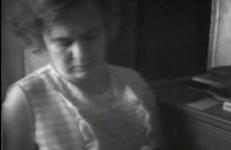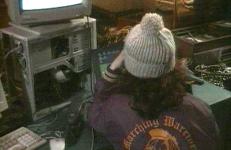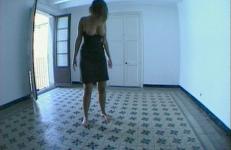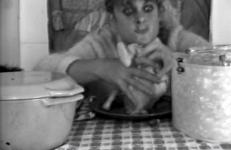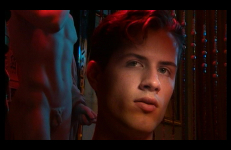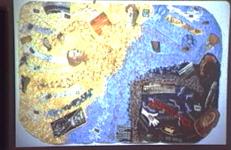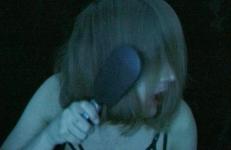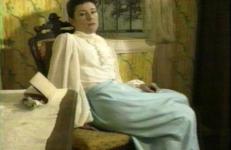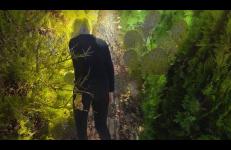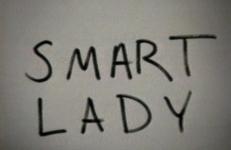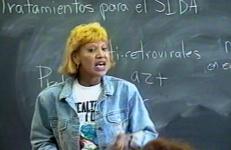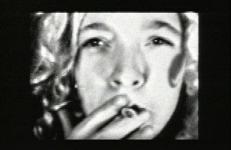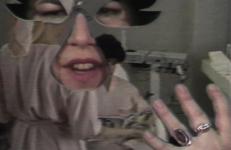In 1971, graduate student Gloria Orenstein receives a call from surrealist artist Leonora Carrington that sparks a lifelong journey into art, ecofeminism, and shamanism. A wife and mother of two writing her dissertation for New York University, Orenstein never expects to have her life transformed through female friendship.
Feminism
With an all-female cast, featuring Suzie Bright as John Lennon, Cecilia Dougherty's Grapefruit plays with the romanticized history of the iconic Fab Four, gently mocking John and Yoko’s banal squabbles and obsessive rituals of self-display. Based obliquely on Yoko Ono’s book, the piece works on many levels to reposition this mythic tale of the Beatles by casting '80s women in mod drag—effectively mapping the lesbian sub-culture onto heterosexual mass culture.
A woman is lying on her back on the floor. She seems to be tied down on the ground, but she is holding her ankles with her own hands. She wears only tights and a pair of high-heeled red shoes. Her hair-covered face makes her an anonymous victim of the camera, which is making converging circles around her body.
This title is also available on Hester Scheurwater Videoworks: Volume 1.
A Hand in Two Ways (Fisted) is a looping meditation on night as space of mysterious energetic transmissions. Animals, human bodies, children, ritual, and performance are investigated as zones of conflict, desire, and a visceral movement that is more felt than seen.
A Hand in Two Ways (Fisted) is a looping meditation on night as space of mysterious energetic transmissions. Animals, human bodies, children, ritual, and performance are investigated as zones of conflict, desire, and a visceral movement that is more felt than seen.
This tape, Harriet, created by Videofreex member Nancy Cain, unfolds much like a short play or literary character study. With very little directed dialogue, we gain intimate entry into a day in the life of Harriet—a long-time resident of Lanesville and mother of five—over the course of one day. No stranger to the Videofreex, Harriet was a frequent guest on the collective’s television production of Lanesville Television, as both an on-screen visitor and routine hotline caller.
“For quite some time the Hamburg artist Cornelia Sollfrank has been researching female hackers and found that hacking is a field completely under male domination. Nonetheless she was able to produce a series of several videos in which she interviewed female hackers. In December 1999 she came to know a U.S. hacker who attended the annual hackers’ convention held by the Chaos Computer Club (CCC). She did the video interview have script, will destroy with her on condition that the woman, code-named Clara G.
A woman is standing barefoot on a tile floor. In slow motion, the investigative camera circles around her. Her breasts are bared and liquid runs down her legs. Bit by bit, every part of her body is shown, except her face, which remains hidden behind her hair. The camera besets the woman, who remains silent.
This title is also available on Hester Scheurwater Videoworks: Volume 1.
In this cooking demonstration/performance, Sobell wears a chicken carcass over her face while dressing (literally, in baby clothes) a chicken to be cooked for dinner. Cooing and breast feeding the chicken as she would an infant, Sobell brings two stereotypical female roles—that of care giver and that of cook—psychotically close, emphasizing the potential dark side of women’s intimate association with food in a way similar to Suzanne Lacy’s Learn Where the Meat Comes From.
Land locked souls seek the key to a spiritual doorway that transcends earthly existence.
You, along with them will unlock and enter the "HOUSE OF THE HOLY GHOST", and when inside; be eternally blessed and forever haunted!
An eloquent personal narrative about the meaning of childhood and the use of children as political tools—specifically by “Right-to-Lifers” participating in the blockades of abortion clinics. Rather than merely constructing a video document of the daily drama surrounding the protests, Wrobel slows down the event and extracts the children's stories. She interlaces this with personal memories of her playful and carefree childhood, and exposes how she too was susceptible when young.
Taped shortly after the creation of the Air Gallery, this conversation between painter Howardena Pindell and Hermine Freed concerns the women’s independent gallery and its role in the feminist movement. Pindell also discusses the development of her work and the relation between black artists and the art world.
Juliana Huxtable was born in Texas and studied at Bard College, NY. An artist working across video, photography, poetry, and music, her practice demands a reexamination of the canon of art history in order to break the cycle of misrepresentation and under-representation in the contemporary art world.
The title gives a bitter meaning to the uneasy image of a woman who is brushing her hair over her face with fierce movements. Mostly the face remains impersonally hidden under her hair; when it is uncovered, we see how the rough scratches of the brush against the skin have smeared her lipstick.
This title is also available on Hester Scheurwater Videoworks: Volume 1.
Juxtaposing feminist readings of medical tracts, narratives of patient treatment and archival footage, I Need Your Full Cooperation reveals the evolution of women’s relationship to modern medicine. The video dramatizes Charlotte Perkins Gilman’s “rest cure”, adapting her 1892 story "The Yellow Wallpaper", and includes critical commentary by activist/writer Barbara Ehrenreich and historian Carroll Smith-Rosenberg.
I Wanted You shows a woman who is crawling over the floor. She is wearing only tights and a pair of red shoes with high heels. Her hair-covered face makes her an anonymous victim of the camera, which is making converging circles around her body.
This title is also available on Hester Scheurwater Videoworks: Volume 1.
I've Been Afraid is a musical encyclopedia about how women get abused, and why it is they stay. It uses emojis that are as ubiquitous as abuse is in our culture.
Music by Isaac Sherman
With wit and humor, seven-year-old Kendra portrays ten female stereotypes, including an ingratiating Southern belle, a motorcycle-riding tough chick, and a simpering housewife. Under the rubric of playing dress-up, the video illustrates the pervasive, prescribed personalities available to women, and the early age at which girls recognize these choices. But, as outtakes reveal, spirited Kendra’s is infinitely more complex than the cardboard cut-outs she depicts.
Setting her pixelvision camera on herself and her room, Benning searches for a sense of identity and respect as a woman and a lesbian. Acting alternately as confessor and accuser, the camera captures Benning’s anger and frustration at feeling trapped by social prejudices.
This title is also available on Sadie Benning Videoworks: Volume 1.
(In) Visible Women shows the heroic responses of three women with AIDS in the context of their respective communities. In the face of adversity, these women confront all aspects of the AIDS crisis in their lives. Through poetry, art, activism, and dance, they explode notions of female invisibility and complacency in the face of AIDS. We hear each woman describe how she came to terms with being HIV+ and joined others in speaking out about the neglected needs of women.
A chilling and revealing look at bureaucratic techno-speak, Finley provides a course in “official” media rhetoric, presenting terms and decoding for the audience (i.e. "soft target = city”, “involuntary conversion = crash”) against a slow-motion collage of military imagery. This intensely visual video illustrates how the urban environment has become the site of tactical language, rendering our daily lives in a science-fiction state of constant fear. The visual elements create a rhythm of threat that is punctuated by high altitude shots of military jets.
Benning illustrates a lustful encounter with a “bad girl,” through the gender posturing and genre interplay of Hollywood stereotypes: posing for the camera as the rebel, the platinum blonde, the gangster, the '50s crooner, and the heavy-lidded vamp. Cigarette poses, romantic slow dancing, and fast-action heavy metal street shots propel the viewer through the story of the love affair. Benning’s video goes farther than romantic fantasy, describing other facets of physical attraction including fear, violence, lust, guilt and total excitement.
The 1970s witnessed unprecedented artistic development of non-traditional media – chief among them were textiles and fabrics. Diane Itter was at the forefront of this boom in craft-oriented art making, designing colorful, geometric and exceedingly intricate fiber works that demanded near countless hours of time to execute. In this interview she discusses her practice, as well as the pitfalls that are encountered while working in what was – at the time of the interview – a still largely marginalized art form.
Dykes and trans guys take over the Jackhammer for a punk show.
This title is also available on Chicago Sex Change: 2002-2008, A collection of Minax's early videos that together create a punk-documentary tapestry of young queer life in Chicago in the early 2000s.
In Joan Does Dynasty — a hilarious classic of feminist media deconstruction — critic Braderman literally projects herself onto the set of the favorite series of one hundred million people in 78 countries. Her do-it-yourself deconstruction of TV’s most successful night-time soap opera is at once a succinct critical analysis of the disturbing cultural assumptions inherent in the narrative, and an unabashed appreciation of the show’s seductive power.








